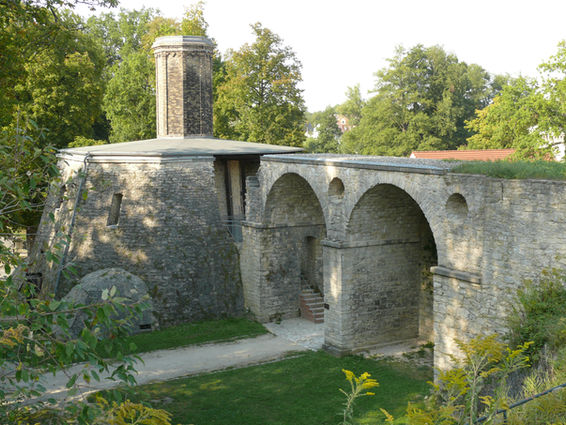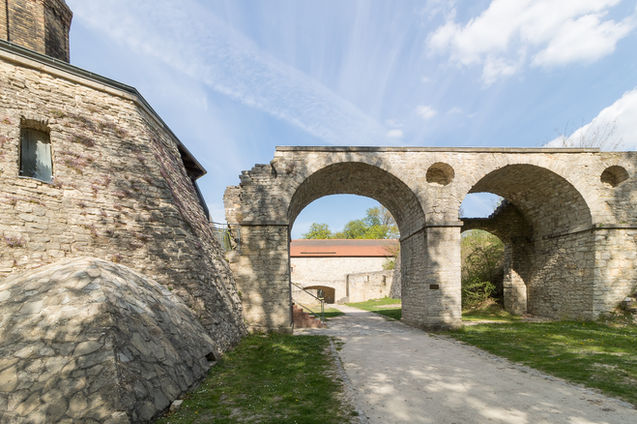Rüdersdorf ovens
Just beyond the entrance to the Museumspark, visitors are captivated by the two iconic Rüdersdorf furnaces, also known as Rumford furnaces after their engineer, Sir Benjamin Thompson, Count Rumford.
Directly below these early industrial milestones, an older chamber furnace dating from 1666 has also been preserved. It is located exactly between the two hexagonal Rumford furnaces. The two ground-level entrances led to the two combustion chambers, the heart of the furnace system. On the left and right sides of the combustion chambers, there were five openings each for air supply, adding firewood, and stoking the fire. Lime burning in the chamber kiln system yielded good results, but only worked with wood as fuel. However, wood became increasingly scarce during the 18th century, so a new burning technique was needed that also worked with peat and coal. The solution was found in Rumford stoves.
The first of these two preserved Rumford stoves was built in 1804 and was a technological pioneer at the time. When it was put into operation in 1804, it still had a cone-shaped roof with an opening for smoke extraction instead of a narrow chimney. A key innovation of the Rumford stove is the separation of limestone and fuel, so that the quicklime is no longer contaminated by ash. The second innovation was that significantly less energy is required to burn the same amount of limestone. The name 'Rumford' comes from its inventor, Benjamin Thompson, who was born in America in 1753 as the son of a small farmer, but less than forty years later was elevated to the rank of count by the Bavarian elector. His title 'Count of Rumford' goes back to a former place of residence and work in his American homeland.
Unfortunately, the outer vault of this Rumford stove is destroyed on one side. However, this helps us to better understand how the stove works today. From the outside, you can see the openings of two of the five combustion chambers, slightly below the level from which visitors look inside. This is where the fuel – mainly peat and later coal – was placed and burned on a walled-in iron grate. The ashes fell through to the bottom, as evidenced by the ash outlets below the combustion chambers. The chimney, through which the heat escaped, is not located directly above the combustion chambers, but further inside the stove. The limestone was fed into this shaft from above, where the narrow, subsequently added chimney now stands. Initially, it was fed in using winches and cumbersome lifts, then via a wooden bridge, and later via the stone bridge (circular arch bridge) that still stands today.
The entire chimney was practically always full from top to bottom – with limestone at the top and quicklime at the bottom. The combustion chambers reached the required temperatures of over 900 degrees, at which limestone is converted into quicklime. Below this combustion zone, the quicklime was able to cool down slightly and could then be removed from the shaft. Between the two ash outlets in the cellar visible from here, there is another opening. It is located further inside, directly at the actual kiln shaft, and this is where the quicklime was removed with a poker. After cooling down somewhat, it was taken by cart to the storage building and packed into barrels.
After removal from the shaft, limestone and quicklime slid down from above. This created space for new material at the top end. The kiln could thus be fed continuously. This ability to produce without interruption was the main advantage of the new firing technique. Up to nine tons of quicklime were produced in this way every 24 hours. The method was so effective that it quickly found imitators, even far beyond Rüdersdorf.
If you follow Heinitzstraße to the rear of the park, you will find a so-called Germanic kiln on your right, which is on permanent loan to the park. Several such kilns have been found in what is now the state of Brandenburg and also in Berlin. Some of them are over two thousand years old and show us how the Germanic tribes used to burn lime. With this model, a wood fire must be kept burning under the limestone vault for many hours. When the limestone becomes hot enough, a layer of quicklime is formed, which can later be knocked off. This quicklime has a wide range of uses, especially for the production of lime mortar or lime paint. In what is now Jordan, houses were already being plastered with lime mortar 8,000 years ago.






